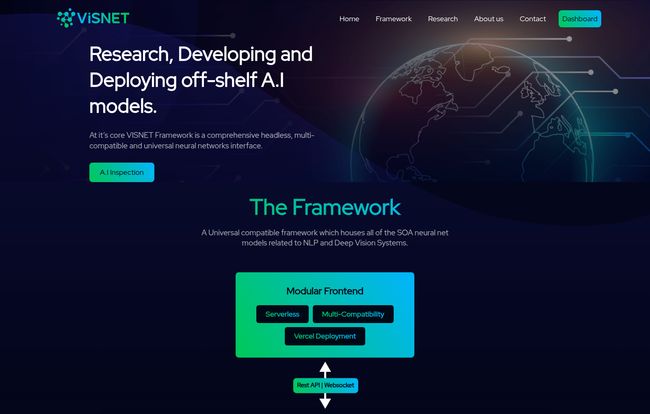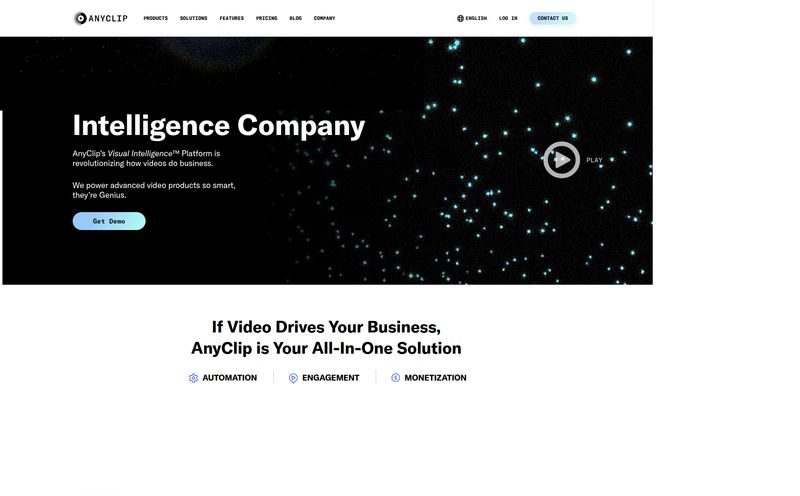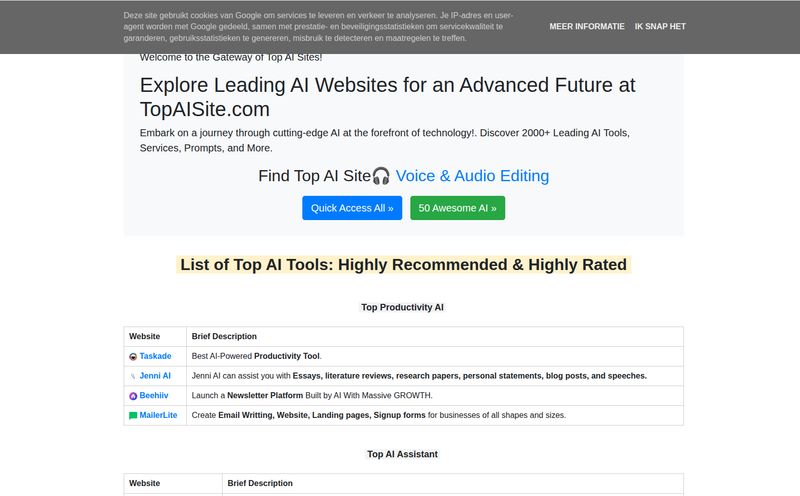Building and deploying AI models can be a real pain. You spend weeks, maybe months, perfecting a neural network. It works great on your local machine. But then comes the hard part: getting it out into the real world, making it scale, and wrapping it in a secure, usable package. It's that classic “last mile” problem that turns so many exciting AI projects into dust bunnies on a hard drive.
Every now and then, a platform pops up that promises to solve this. They all claim to be the one-stop-shop, the silver bullet. So when I came across Visnet, I was intrigued but, you know, skeptical. Their pitch? A headless, multi-compatible, and universal neural networks interface. That’s a lot of buzzwords, but the core idea—a flexible foundation for off-the-shelf AI—definitely got my attention.
What Exactly is Visnet? A Look Under the Hood
So what does “headless” even mean in this context? Think of it like a high-performance engine for your AI car. Visnet provides the powerful, complex engine (the AI models and processing), but you, the developer, get to build the car's body, interior, and dashboard (the frontend or user interface). This is fantastic for flexibility. You're not locked into their look and feel; you just plug their brain into your application.
At its heart, Visnet is a universal framework built around SOA (Service-Oriented Architecture) neural net models. It aims to be the go-between, the universal translator, for a bunch of different AI tasks. The whole thing is built on a pretty modern stack, mentioning serverless multi-compatibility and a Universal ASGI Gateway, which will make any Python developer's ears perk up.
The Core Features That Got My Attention
Alright, let's break down the architecture they're so proud of. It’s essentially built on three main pillars.
A Solid and Secure Foundation
First up is their High Performance Gateway. This isn't just about speed; it’s about security. They're talking DDOS protection and IP filtering right out of the box. In an era where security is anything but an afterthought, seeing this built into the foundation is reassuring. It means you’re not starting from zero when it comes to protecting your application.
A Flexible Connection Layer
Next is the Auth Protocol Layer. This is the nitty-gritty of how your app will talk to Visnet's AI brain. With support for both Rest API and Websockets, they’re covering the most common use cases for web and real-time applications. Add in RSA encryption for the auth protocol, and you have a respectable, secure pipeline for your data. It’s the kind of stuff that shows they're thinking about real-world deployment, not just academic projects.
The Ready-to-Use AI Models
This is the fun part. The Core AI Models. Visnet isn't just an empty framework; it comes with some pre-trained, off-the-shelf models you can use immediately. They highlight a few key ones:
- Translation: Pretty standard, but always useful.
- License Plate Recognition: A huge one for logistics, security, and smart city applications. They claim it can handle 20 vehicles in a single frame, which is pretty impressive.
- Face Feature Matching: This is for high-end security, authentication, and registration systems. It’s not just recognizing a face, but matching its distinct features.
These aren't just toys. These are serious tools for building some powerful applications.

Visit Visnet
Where Visnet Could Really Shine
A platform is only as good as its practical applications. Looking at their highlighted research areas, you can see where their focus lies. And honestly, it's pretty smart.
Their work on Drone Structural Inspection is particularly interesting. They've partnered with AI VIEWGROUP, which they describe as India's largest autonomous drone company. This isn't just a random collaboration; it’s a massive signal. It suggests their AI is being battle-tested for things like finding defects in bridges, turbines, or buildings. Giving drones a specialized brain to spot tiny cracks from 100 feet in the air? That’s a game-changer for industrial maintenance and safety.
This, combined with their focus on facial recognition and license plate tracking, paints a clear picture. Visnet is positioning itself as a serious player in the world of AI-powered inspection and surveillance.
Let's Be Real: The Good, The Bad, and The Missing
Okay, no tool is perfect. As a professional, I'm always looking for the catch. So, after digging around, here’s my balanced take.
The Advantages of Visnet
The biggest pro here is the headless, universal nature of the platform. For a development team that wants total control over their user experience but doesn't want to build every single AI model from scratch, this is ideal. The scalability and built-in security features are also huge pluses. And that AI VIEWGROUP partnership? It adds a ton of credibility. It shows their tech isn’t just theoretical.
The Potential Hurdles
Now for the other side of the coin. The website and provided info suggest this isn't for a beginner just dipping their toes into AI. To really get the most out of Visnet, you'll likely need some solid expertise in AI concepts and maybe even neural networks. It’s a tool for professionals, not a weekend hobby kit. Also, their specific mention of deployment through Vercel might be a slight constraint for teams standardized on other platforms like AWS or Azure. It's not a dealbreaker, but something to be aware of.
My biggest question mark, however, is the lack of public-facing performance metrics. For any serious production system, I need to know the accuracy of that license plate reader, the false positive rate on the facial matching, and the latency of the translation API. Without those benchmarks, it’s hard to make a final decision. I'm sure they provide them to serious customers, but it's a gap in their public info.
The Hunt for a Price Tag
I did what any potential user would do: I looked for the pricing page. And… I found a classic 404 “File not found” page. Whoops. Happens to the best of us! But it does tell me something important. Pricing is almost certainly a “contact us for a quote” situation. This is common for enterprise-level or B2B tools, so it's not a huge shock. Just don't expect to find a neat little pricing table with Bronze, Silver, and Gold tiers.
Who Should Actually Use Visnet?
So, who is the ideal customer here? In my opinion, it's not the solo founder trying to build an MVP on a shoestring budget. It’s also probably not the massive enterprise that already has its own in-house MLOps teams.
Visnet seems perfectly positioned for mid-sized companies and well-funded startups that have a strong development team but lack a dedicated AI research division. If you're a company in logistics, private security, or industrial inspection, and you need to add a powerful AI feature to your existing product, Visnet could be your fast-track solution. It lets you skip the model-building nightmare and get straight to integration.
Frequently Asked Questions about Visnet
What is Visnet in simple terms?
Visnet is a flexible, headless AI framework. It provides pre-built artificial intelligence models (like face and license plate recognition) that developers can easily integrate into their own applications, without having to build the AI from the ground up.
Is Visnet suitable for beginners?
Probably not. While it simplifies AI integration, fully utilizing Visnet likely requires a good understanding of software development, APIs, and possibly some AI concepts. It's designed more for professional developers and teams.
What kinds of AI models does Visnet offer?
Their core offerings include AI models for real-time translation, license plate recognition for multiple vehicles, and detailed facial feature matching for security and authentication purposes. They also specialize in AI for drone-based structural inspections.
How does Visnet handle security?
Security seems to be a core part of their architecture. They offer a high-performance gateway with built-in DDOS protection and IP filtering, along with an authentication layer that uses RSA encryption.
Is Visnet's pricing available publicly?
No, there is no public pricing page available on their website. This typically means they operate on a quote-based model where you contact their sales team to get pricing tailored to your specific needs.
Who is the team behind Visnet?
Visnet is run by a team of committed researchers and engineers, including Sai Krishna Uppuluri, Gowtham Chintada, and Madhu Sekhar Attada. Their background appears to be in deep vision systems and AI research, and they are part of the #startupindia initiative.
Final Thoughts on This AI Framework
So, is Visnet the AI toolkit we've all been waiting for? Maybe. It depends on who "we" are.
It's not a magic wand that will instantly create an AI-powered app for you. But it is an ambitious and seemingly powerful framework that could save a development team thousands of hours. It addresses a very real need: making sophisticated AI more accessible to build with. The focus on industrial applications and the credible partnership with a drone company show that this is more than just an idea; it's a tool being forged in teh real world.
I'm genuinely curious to see how Visnet develops. If they can make their performance metrics more transparent and streamline their onboarding, they could become a go-to name for companies looking to integrate serious AI without the massive overhead. It's one to watch, for sure.
Reference and Sources
Visnet Official Website: visnet.tech
Collaboration Partner: AI VIEWGROUP
Deployment Platform: Vercel
Further Reading on Headless Architecture: What Is a Headless System?



